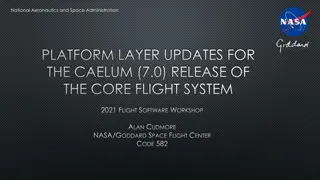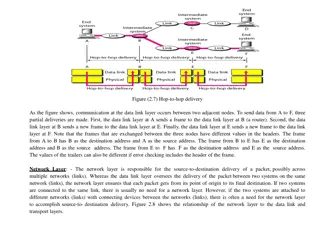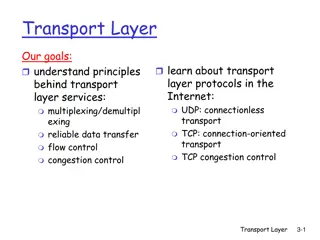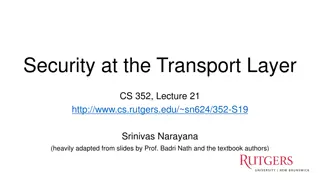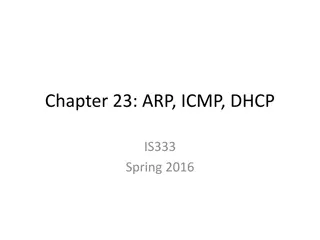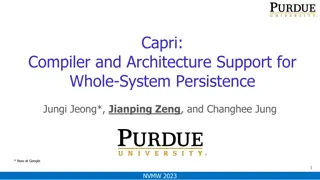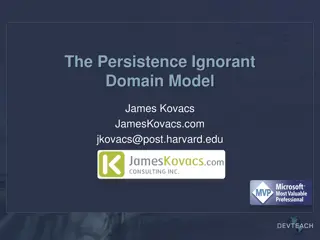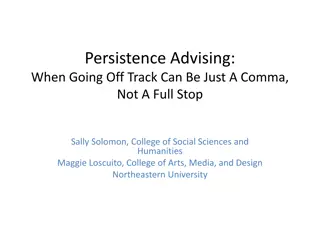Headless with Cassandra: Simple, Reliable Persistence Layer
This article explores the implementation of a headless architecture using Cassandra as a reliable persistence layer for the NYTimes global messaging platform. It delves into the challenges faced in scaling millions of clients and dozens of systems, offering technical solutions and insights into the architectural platform known as nytarik. The platform facilitates rapid message exchange between NYTimes systems and client devices, functioning as a chat system for various connected entities. Additionally, it emphasizes the importance of a message cache for optimal performance.
Download Presentation

Please find below an Image/Link to download the presentation.
The content on the website is provided AS IS for your information and personal use only. It may not be sold, licensed, or shared on other websites without obtaining consent from the author.If you encounter any issues during the download, it is possible that the publisher has removed the file from their server.
You are allowed to download the files provided on this website for personal or commercial use, subject to the condition that they are used lawfully. All files are the property of their respective owners.
The content on the website is provided AS IS for your information and personal use only. It may not be sold, licensed, or shared on other websites without obtaining consent from the author.
E N D
Presentation Transcript
Headless with Cassandra a simple, reliable persistence layer for the nyt a rik global messaging platform Michael Laing 2014-02-02
Me Systems Architect NYTimes michael.laing@nytimes.com
nytarik Why the funny characters? What is it anyway?
Messaging everywhere Simpler Scalable Resilient nyt a rik Add just enough structure to the Internet cloud
Connect clients to systems via a bus Clients NYT Systems Bus
Problems: scale Millions of clients Dozens of systems Global Highly variable load
Technical problems: Our solutions Backbone messaging: AMQP (RabbitMQ) Client messaging: websockets / sockjs (pylws - to be open sourced) Global, scalable resources: cloud (AWS)
Problems: architecture RabbitMQ Excellent for routing Excellent for queuing Not a database Websockets / sockjs Excellent for message interchange Really not a database! But we need a message cache Unconnected clients Archiving Analysis
So what is nytarik? It s an architectural platform that allows dozens of NYTimes systems and millions of client devices to rapidly exchange billions of messages It s a chat system for things that belong to us and to our clients and partners - phones, web browsers, refrigerators, advertisements, etc. (It s also a system for the rest of us ) It needs a cache
Dont forget the cache... Clients NYT Systems nyt a rik Messaging Fabric Cache
The message cache Simple Performant Global
A simple message structure A message has: message_uuid (a version 1 UUID) replica_uuid (a version 1 UUID) metadata (JSON) optional body (BLOB - large ones are referenced in metadata) a time-to-live (ttl - all ttls are < 30 days)
Simple message indexing A message has one or more paths carried in its metadata Each path is comprised of: collection hash_key range_key (implicit = message_uuid) An example: collection: feeds.breaking-news hash_key: 12345 path: feeds.breaking_news.12345 [UUIDs]
Simple query patterns: get latest Get latest messages in a subtree: Walk a subtree of the path return the latest message for each complete path found Used to: Get the latest versions of news items within a category, e.g. query path feeds.breaking-news.# will retrieve the latest version of each breaking news item Get the latest versions of client information for a client
Simple query patterns: get all Get all unexpired messages for a path up to a limit: Find the path Return messages in reverse date order up to the limit Used to: Get metrics from a time bucket, e.g. query path metrics.searchcloud.minute.2014-02-01T09:39Z will retrieve all the messages in that bucket Get all the unexpired versions of a specific information set, e.g. a to do list
Other simple query patterns Get a message by message_uuid: Get all messages by time bucket (journal) Get a range of paths
Why NoSQL? Reality intrudes...
I love relational whatever! I remember pre-SQL CODASYL Cullinet Pick Track/block ... I started with relational algebra and calculus Some nerdy stories ok I ll keep it short!
Relational = Beautiful IMHO: the mathematical grounding provides elegance and power But! Another story, older and perhaps more relevant... Reality cannot always be addressed by closed form solutions Some factors push you out of the SQL sweet spot: Time Space Volume
Reality bites Goals for the nyt a rik message cache: globally distributed high volume low cost resilient NoSQL is the answer (read up on the CAP theorem if you don t know it)
Reality bites again on the other leg NoSQL doesn t do as much for us - we have to do it ourselves Answers: do it in the application simplify re-simplify ok really simplify this time
Why Cassandra? A process of elimination...
Criteria for cache Multi-region (global) Open source (no license fee) Scalable cost and volume Manageable - not Java
Possible answers AWS Dynamo great scalability and manageability our first implementation not multi-region... Riak scalable, manageable have to pay for multi-region Cassandra scalable, might be manageable (Java ) new version w improved language, new interface library... do it!
Caveat emptor All interaction with the cache is strictly isolated in nyt a rik - we can switch cache backends very quickly We are willing to dive into open source code to contribute fixes and already have with Cassandra (python interface)
Implementing Cassandra Which version? Which interface library? Which features? Oops...
Choices choices... Initial requirements are pretty small: hundreds of reads/writes per second Aggressive (2.0.n) or safe (1.2.n)? 1.2 has enough features but uses Java 6: difficult to manage on small machines 2.0 uses Java 7: MUCH better behaved on small machines Features? Minimize the use of newer features: secondary indexes, leveled compaction, etc.
Mistakes Using the collections feature to implement message structure The entire collection is read whenever a message is read Should have known better - restructured tables to remove collections Black launch then launch 8 Jan and aftermath... Application oversights create 10-100X expected volumes Some paths written to millions of times resulting in huge rows Nodes fail and are rebuilt Queuing, parallelized workers, autoscaling, etc. compensate.for errors so... No one notices
Global in the cloud Spreading clusters across zones
Amazon Web Services Regional cluster 6 nodes: 2 per zone m1-medium: 1 virtual CPU, 3.4GB memory, 400GB disk (these machines are WAY small! we launched anyway) replication factor = 3 Each region supporting 10 to 100 other nyt a rik instances 2 regions currently: Dublin and Oregon - may add Tokyo, S o Paulo, Singapore, Sydney,...
Lessons / Advice Keep it simple - use the defaults Keep it simple - evolutionary design
Staying in the Cassandra sweet spots Starting out? Use version 2, use cql3, use the defaults, be wary of features Really. USE THE DEFAULTS! Have a good reason to deviate. A good reason: we never use delete , are careful w overwrites, and manage data size with truncates and ttls. Hence we can: Garbage collect immediately (gc_grace_period = 0) Avoid periodic repair of nodes (big load on small machines)
Evolve your design Cassandra is not happy about some schema changes avoid dropping and recreating this will get better Watch usage patterns and progressively simplify Writes are so cheap that we run versions of tables in parallel We gradually migrate code to use new versions Much of our tweaking has to do with avoiding large rows
nytarik: next? Metrics - generated by internal systems User events - generated by client devices Result: substantially higher volumes
Metrics: gotta love them too! First project going into production this week: searchcloud what are people searching for not too much volume no rollup or cache access initially Underway: Cassandra metrics! 1400+ metrics differential protocol buffers blog posts soon Future: metrics supporting analytical client apps
Events happen... Lots of potential user events Websockets provides an efficient 2-way connection for gathering events Scaling needed for the cache: up: bigger instance types to regain the Cassandra sweet spot out: more nodes nothing else changes :)




